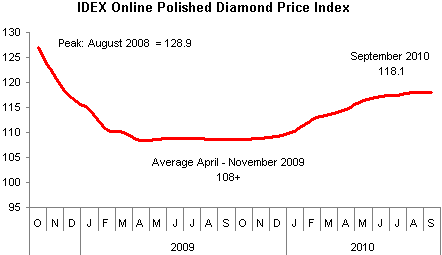IDEX Online Research: Polished Diamond Prices Steady in September
October 05, 10
(IDEX Online News) - Global polished diamond prices held relatively steady in September. The IDEX Online Polished Diamond Price Index averaged 118.1 for the month, barely up from the average of 117.9 for August.
September ended weaker than it began: early in the month, the IDEX Online Index reached as high as 118.4 on a daily basis, but by the end of the month, it had dropped to just below 117.9.
Month-to-month increases in polished diamond prices have diminished over the past four months, after posting solid gains earlier this year. On a year-to-year basis – comparing September 2010 to September 2009 – polished diamond prices are still showing large gains. The IDEX Online Index hit its lowest point in the recession price trough during September 2009, so it is no surprise that the year-over-year percentage gains are still relatively large due to very easy comparisons.
What has caused the upward momentum of polished diamond prices to stall? Several factors have an impact on polished diamond prices:
· Polished diamond prices are set by a true capitalistic market of “supply and demand.” Since it is a closed market, short-term oriented financial traders are not whipsawing prices. Thus, the current lack of price momentum for polished diamonds is largely related to weak demand at the consumer level.
· Manufacturers want to push prices back up as close as possible to pre-recession levels in an effort to regain profits lost during the recessionary period of the past two years.
· Retail jewelers are unwilling to pay higher prices for polished diamonds, especially in the face of soft demand from consumers. Retail jewelers are dealing with a couple of factors which have kept their demand for diamonds only lukewarm:
o The average ticket for diamond jewelry in the U.S. market has fallen by about 9 percent, according to the latest data from The Edge. Diamond consumers appear to have curbed their appetite for larger, higher-priced diamonds in favor of lower-cost diamonds.
o Diamonds now represent a notably smaller portion of a typical U.S. jeweler’s sales mix. In the past two years, diamonds and diamond jewelry have fallen from 47 percent of a jeweler’s sales mix to 43 percent of sales, a sharp decline. This is due to four factors:
§ The average ticket is down.
§ Consumers are opting for other jewelry, such as colored stone jewelry because they can get the same “flash” for less cash.
§ Jewelers have been focusing on non-diamond merchandise which carries higher gross margins. Because diamonds have become a commodity, diamond margins are below the average of most other merchandise in a jeweler’s store.
§ Due to less advertising in the U.S., diamonds are no longer a top-of-mind product when consumers think of luxury goods.
With diamonds and diamond jewelry being less important to jewelry consuming customers, especially in the American market, they are also less important to retail jewelers.
The only real demand for polished diamonds is coming from jewelers who are re-stocking their showcases in anticipation of the upcoming holiday selling season during November and December.
Most forecasts call for 2010 holiday sales – November and December – to be modestly better than last year, but not particularly strong. The preliminary IDEX Online holiday sales forecast for the U.S. market calls for jewelry sales to up by perhaps 3 percent at most, with diamond sales ahead by no more than 2 percent.
With near-term consumer demand predicted to be up by only a low single-digit level, it is no wonder that retail jewelers have held back ordering more diamond jewelry.
IDEX Online Research noted recently that retail prices of jewelry had finally begun to edge up, but this was due entirely to higher precious metals prices, not diamond prices.
Because diamonds have become a commodity, jewelers’ pricing power is limited, and margins are under pressure. Thus, jewelers have been focusing on other merchandise which offers them the opportunity to boost their margins.
Will diamond prices edge higher? As the global economy continues to recover, diamond prices are expected to rise, perhaps more slowly than many anticipate.
The economic recovery continues, but at a slow pace. Most economists do not forecast a double-dip recession, but they do predict that the recovery could take another two or three years. Historically, jewelry and diamond demand have correlated very closely with economic cycles. We would expect this to be the case in the current recovery.
The graph below summarizes global polished diamond prices for the past two years based on the IDEX Online Polished Diamond Price Index.
 Source: IDEX Online |
The full analysis of the polished diamond prices is available to IDEX Online Research subscribers and IDEX Online members here. Click here for more information on how to subscribe or become a member.